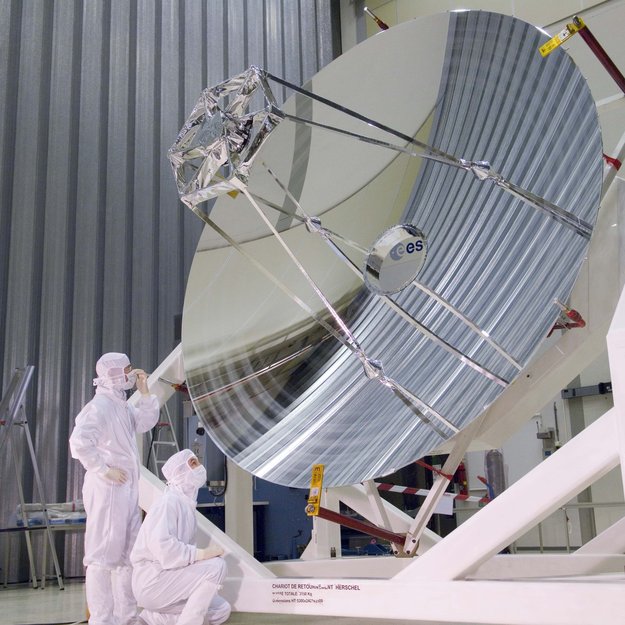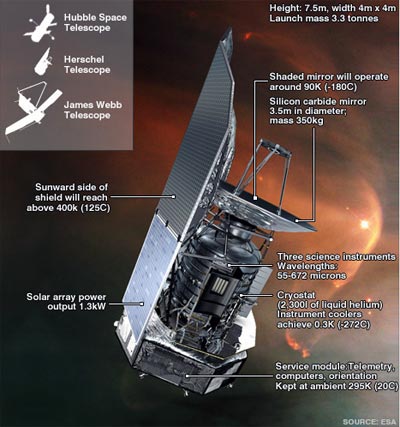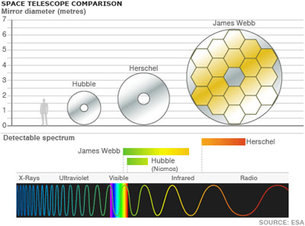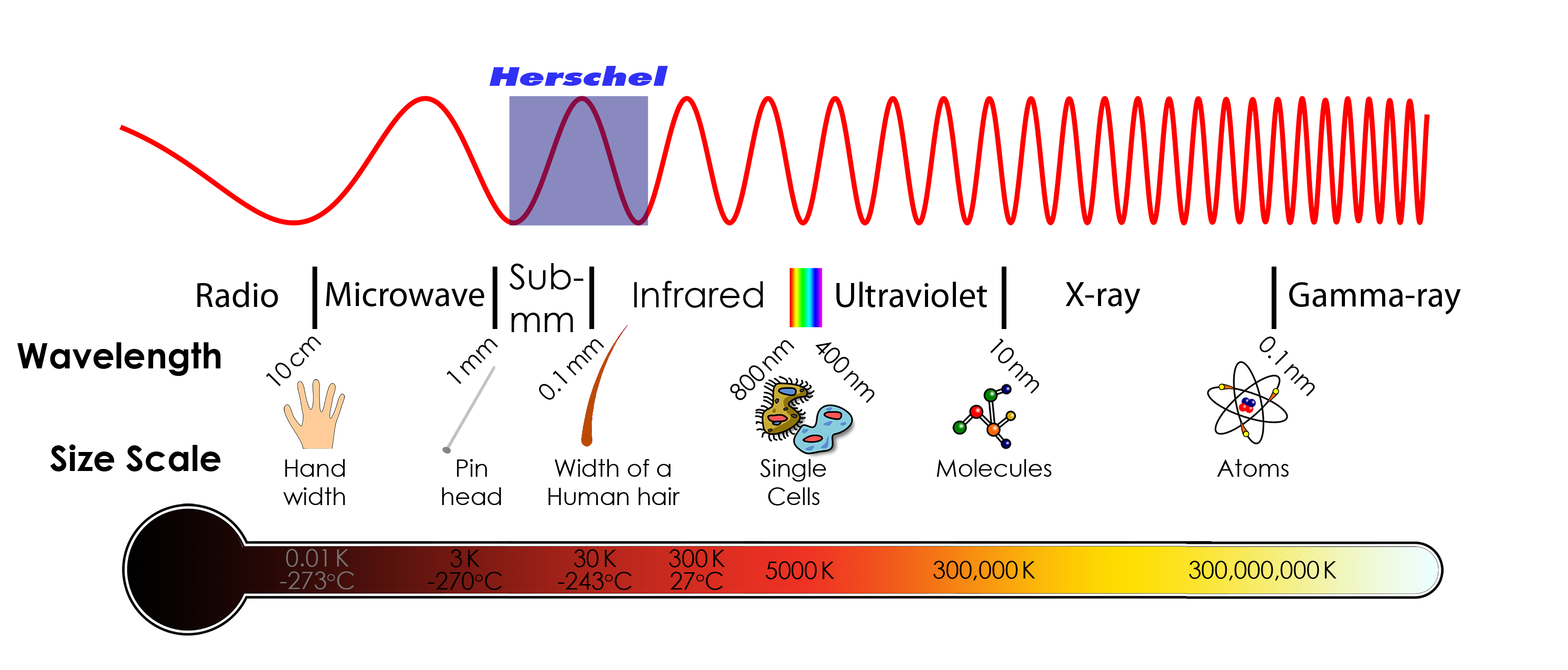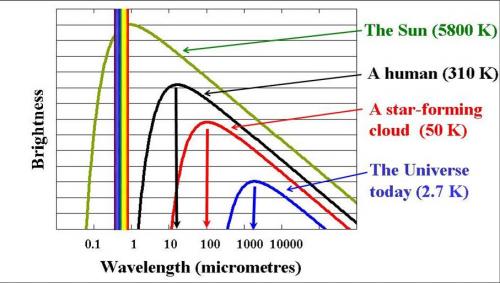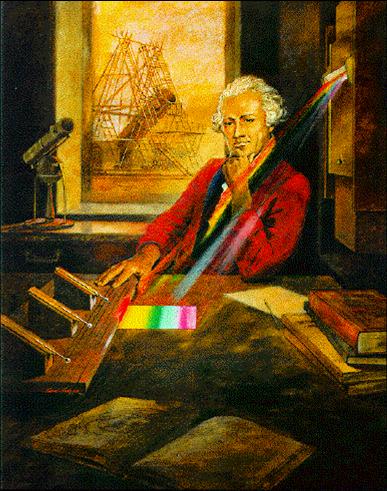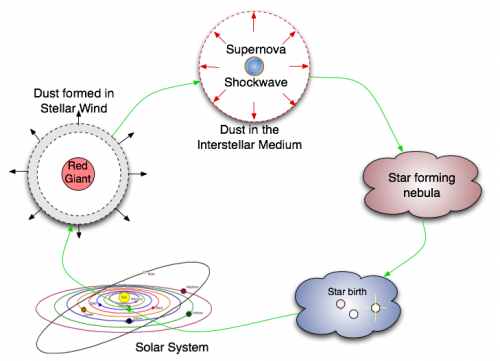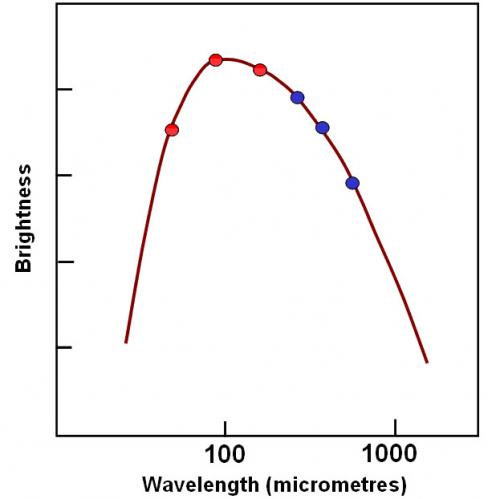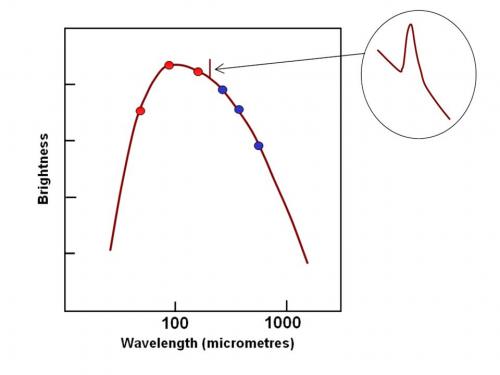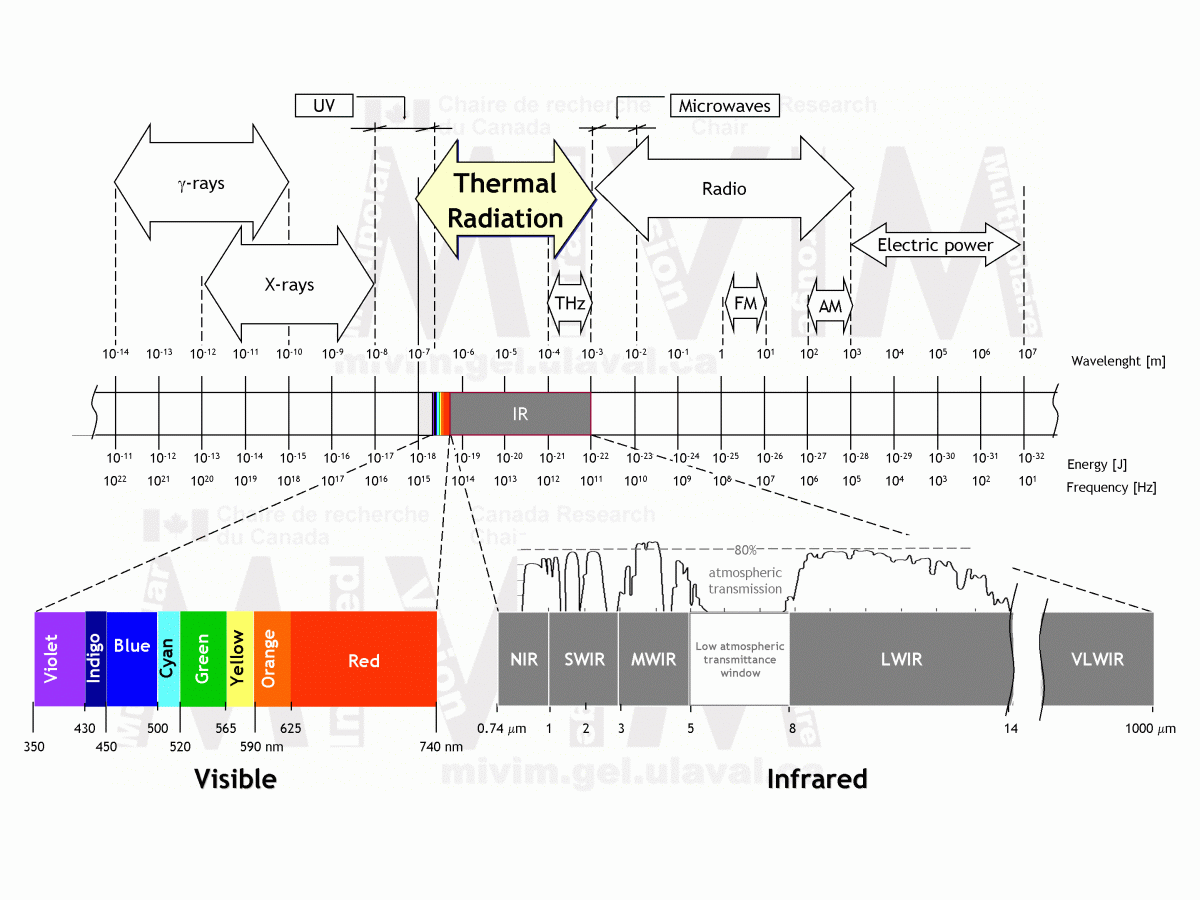Difference between revisions of "Herschel Space Observatory"
| (53 intermediate revisions by the same user not shown) | |||
| Line 2: | Line 2: | ||
---- | ---- | ||
| + | |||
| + | ---- | ||
| + | |||
| + | '''A Brief History of the Herschels:''' | ||
Caroline and William Herschel: The Herschels were pioneers of the systematic classification and investigation of the heavens. William Herschel was one of the first 'professional' astronomers, and discovered infrared radiation. His sister Caroline helped him to develop the modern mathematical approach to astronomy. | Caroline and William Herschel: The Herschels were pioneers of the systematic classification and investigation of the heavens. William Herschel was one of the first 'professional' astronomers, and discovered infrared radiation. His sister Caroline helped him to develop the modern mathematical approach to astronomy. | ||
| Line 10: | Line 14: | ||
| − | Herschel is the largest infrared space telescope ever launched. With its 3.5-m primary mirror, it is four times bigger than any previous infrared space telescope and almost one and a half times larger than the Hubble Space Telescope. | + | The Herschel Space Observatory is the largest infrared space telescope ever launched. With its 3.5-m primary mirror, it is four times bigger than any previous infrared space telescope and almost one and a half times larger than the Hubble Space Telescope. |
| + | |||
| + | ---- | ||
| + | '''Herschel - the Space Observatory:''' | ||
| + | ESA’s cutting-edge space observatory, carries the largest, most powerful infrared telescope ever flown in space. A pioneering mission, it is studying the origin and evolution of stars and galaxies to help understand how the Universe came to be the way it is today. | ||
| + | [[File:scope.jpg|400px|thumb|right|Comparisons]] | ||
| + | |||
| + | |||
| + | The first observatory to cover the entire range '''from far-infrared to submillimeter''' wavelengths and bridge the two, Herschel is exploring further into the far-infrared than any previous mission, studying otherwise invisible dusty and cold regions of the cosmos, both near and far. Including the area called NGC281, or the Pacman Nebula, this is the area that SHIPs is researching for their project during 2013. | ||
| + | |||
| + | By tapping these unexploited wavelengths, Herschel is seeing phenomena beyond the reach of other observatories, and studying others at a level of detail that has not been captured before. The telescope’s primary mirror is 3.5 m in diameter, more than four times larger than any previous infrared space telescope and almost one and a half times larger than that of the Hubble Space Telescope. Its size is allowing Herschel to collect almost '''20 times more light''' than any previous infrared space telescope. | ||
| + | |||
| + | The spacecraft carries three advanced science instruments: two cameras and a very high-resolution spectrometer. The detectors in these instruments are cooled to temperatures close to absolute zero by a sophisticated cryogenic system. | ||
| + | |||
| + | |||
| + | '''Launch:''' 14 May 2009 on an Ariane 5 from ESA’s Spaceport in Kourou, French Guiana. The launch took place at 13:12:02 GMT. Herschel was launched along with Planck, ESA’s microwave observatory, which is studying the Cosmic Microwave Background. (See other NITARP Projects using Planck) | ||
---- | ---- | ||
| Line 16: | Line 35: | ||
Herschel's primary mirror is the telescope's light collector. It captures the light from astronomical objects and directs it towards the smaller secondary mirror. The two mirrors work together focusing the light and directing it to the instruments, where the light is detected and analysed, and the results recorded by the onboard computer. | Herschel's primary mirror is the telescope's light collector. It captures the light from astronomical objects and directs it towards the smaller secondary mirror. The two mirrors work together focusing the light and directing it to the instruments, where the light is detected and analysed, and the results recorded by the onboard computer. | ||
| − | [[File:space_telescope_comparison_medium.jpg| | + | [[File:space_telescope_comparison_medium.jpg|600px|thumb|right]] |
| − | The size of the primary mirror is the key to | + | The size of the primary mirror is the key to any telescope's sensitivity: the bigger it is, the more light it collects, and the fainter the objects it sees. It also determines the telescope's ability to distinguish fine details. The surface of the mirror is very important, too. It has to be precisely shaped and perfectly smooth, since the slightest roughness distorts the final image. |
| − | + | A mirror must be light and sturdy to withstand the extreme conditions of launch (where it was shaken with a force several times that of Earth’s gravity), and the low temperatures of outer space; and any bump on its surface must be less than a thousandth of a millimetre high. | |
| − | |||
This technological marvel has been constructed almost entirely of silicon carbide. The primary mirror has been made out of 12 segments brazed together to form a monolithic mirror which was machined and polished to the required thickness (about 3 mm), shape, and surface accuracy. | This technological marvel has been constructed almost entirely of silicon carbide. The primary mirror has been made out of 12 segments brazed together to form a monolithic mirror which was machined and polished to the required thickness (about 3 mm), shape, and surface accuracy. | ||
---- | ---- | ||
| − | Vital Stats: | + | '''Vital Stats:''' |
| − | + | The Herschel satellite is a tall cylinder, about 7.5 m high and 4.0 m wide, with a launch mass of around 3.4 tonnes. | |
{| class="wikitable" | {| class="wikitable" | ||
| Line 74: | Line 92: | ||
---- | ---- | ||
| + | '''Herschel Space Telescope Science Objectives:''' | ||
| + | Herschel is set to revolutionize our understanding of the Universe. A versatile infrared space telescope, Herschel's main objective is to study relatively cool objects across the Universe: in particular the formation and evolution of stars and galaxies, and the relationship between the two. | ||
| + | |||
| + | '''Within our Galaxy, the mission’s main science objectives are:''' | ||
| + | |||
| + | To study Solar System objects such as asteroids, Kuiper belt objects, and comets. | ||
| + | Comets are the best-preserved fossils of the early Solar System, and hold clues to the raw ingredients that formed the planets, including Earth. | ||
| + | |||
| + | To study the process of star and planet formation. | ||
| + | Herschel is unique in its coverage of a wide range of infrared wavelengths, with which it is looking into star-forming regions in our Galaxy, to reveal for the first time different stages of early star formation and the youngest stars. The telescope is also studying circumstellar material around young stars, where astronomers believe that planets are being formed, and debris discs around more mature stars. | ||
| + | |||
| + | To study the vast reservoirs of dust and gas in our Galaxy and in other nearby galaxies. | ||
| + | Herschel is studying in detail the physics and kinematics at work in giant clouds of gas and dust that give rise to new stars and associated planetary bodies. Herschel is also well suited to studying astrochemistry providing fundamental new insights into the complex chemistry of these molecular clouds, the wombs of future stars. | ||
| + | |||
| + | '''Outside our Galaxy, the mission’s main science objectives are:''' | ||
| + | |||
| + | To explore the influence the galactic environment has on interstellar medium physics and star formation. Most of what we have learned about the physics and chemistry of the interstellar medium, and about the processes there such as star formation has been gained by studies in our own Galaxy. With Herschel, we can carry out similar studies in relatively nearby galaxies as well. For example, studies of nearby low-metallicity galaxies can open the door to the understanding of these processes in the early Universe. | ||
| + | |||
| + | To chart the rate of star formation over cosmic time. We know that star and galaxy formation commenced relatively early after the Big Bang. We also know that when the Universe was about half its current age, star formation was much more intense than it is today. Herschel is ideal for studying infrared-dominated galaxies at the peak of star formation. | ||
| + | |||
| + | To resolve the infrared cosmic background and characterise the sources. About half the energy produced and emitted throughout cosmic history now appears as a diffuse infrared cosmic background. With its large telescope, Herschel is resolving the far-infrared background and characterising its constituent sources to a level of detail never achieved before. | ||
| + | |||
| + | ---- | ||
| + | |||
| + | '''What is infrared light?''' | ||
| + | |||
| + | The electromagnetic spectrum: | ||
| + | |||
| + | [[File:herschel.png|600px|thumb|left]] | ||
| + | The electromagnetic spectrum spans a wide range of wavelengths from very short wavelength and highly energetic gamma rays to very long wavelength and low-energy radio waves. The visible part of the spectrum is only a small portion. Infrared light is the same as the light that we can see except that the wavelength is longer and outside the range that our eyes can sense. | ||
| + | |||
| + | |||
| + | |||
| + | |||
| + | |||
| + | |||
| + | |||
| + | |||
| + | |||
| + | |||
| + | |||
| + | ---- | ||
| + | |||
| + | Electromagnetic radiation from objects at different temperatures | ||
| + | |||
| + | [[file:curves.jpg|400px|thumb|right]] | ||
| + | |||
| + | In fact all objects glow (emit electromagnetic radiation), and they do this in the part of the electromagnetic spectrum that depends on their temperature. The diagram on the right shows how bright objects of different temperatures appear at difference wavelengths. | ||
| + | |||
| + | The Sun has a surface temperature of nearly 6000 Kelvin (where the Kelvin temperature scale is the same as the familiar Centigrade scale except that the zero degrees C is about 273 degrees Kelvin). Its radiation peaks in the visible part of the spectrum at wavelengths of about half a micron, as shown by the yellow-green line in the graph above. | ||
| + | Infrared radiation was discovered by William Herschel in 1800. He was studying the heating effect of different colors of light by using a prism to produce a spectrum of colours and thermometers to measure their heating effect. He noticed that the heating effect got stronger as he went from the blue end of the spectrum to the red. In a moment of inspiration, he moved the thermometer beyond the visible red end and found that the heating effect was even greater. | ||
| + | [[File:prism.jpg|200px|thumb|left]] | ||
| − | + | It is interesting that the basic technique used by Herschel to discover infrared radiation is still used in modern instruments today, including instruments on board the Herschel satellite – the only real difference is a factor a billion or so in sensitivity. | |
| − | + | ||
| − | + | The whole region with wavelengths ranging from 1 micron to 1 mm is loosely called the “infrared”, but astronomers tend to break this up into sub-regions: the “near infrared” (from 1 to 5 microns); the “mid infrared” (5 to 30 microns), the “far infrared” (from 30 to 300 microns) and the “submillimetre” (from 300 microns to 1 mm). The exact boundaries are somewhat arbitrary, and the exact definitions can vary. | |
| − | + | ||
| − | + | We humans, slightly warmer than room temperature, glow in the mid infrared and we’re brightest at about 10 microns wavelength (black line in the graph). These days we are all familiar with infrared imaging, which allows us to see in the dark using electronic detectors that record infrared light emitted by warm objects such as people. | |
| − | + | ||
| − | + | Clouds of interstellar gas and dust that form stars are typically at temperatures of about 50 K (that’s about –220oC). They glow at far infrared wavelengths and are brightest at about 100 microns (red line in the graph above). And the universe itself is filled with radiation corresponding to a temperature of just less than 3 K – very cold indeed – with peak emission in the millimetre wavelength range (blue line in the graph above). | |
| + | |||
| + | Clearly, depending on what it is that we want to observe, we need to look in different parts of the spectrum, and no one part will tell us everything. The Earth's atmosphere transmits well in the visible and radio regions, but it blocks out everything from gamma rays to ultraviolet and most of the infrared. So to study the Universe at those wavelengths we need to launch space-borne observatories. | ||
| + | |||
| + | ---- | ||
| + | '''Cosmic Dust''' | ||
| + | |||
| + | The Universe is a very dusty place. Cosmic dust consists of tiny particles of solid material floating around in the space between the stars. It is not the same as the dust you find in your house but more like smoke with small particles varying from collections of just a few molecules to grains of 0.1 mm in size. Dust is important because we find lots of it around young stars. In fact it helps them to form, and it is also the raw material from which planets like the Earth are formed. | ||
| + | |||
| + | The diagram below illustrates the cosmic dust cycle. Dust is formed in stars and is then blown off in a slow wind or a massive star explosion. The dust is then 'recycled' in the clouds of gas between stars and some of it is consumed when the next generation of stars begins to form. Astronomers used to consider dust as a nuisance because it absorbs the visible light from objects, keeping them hidden from our optical telescopes making the Universe appear very dark and hiding a lot of interesting things from us. But these dusty clouds have silver linings, however. When astronomers started to use infrared cameras, they discovered that the annoying cosmic dust is actually very interesting and important to lots of astronomical processes. The dust converts the stolen starlight it absorbs into light at longer wavelengths. Astronomers can see the dust shining using special instruments sensitive to the far-infrared and submillimetre part of the electromagnetic spectrum. Herschel is designed to work at these wavelengths, and will be able to see the dust shining at temperatures between 8 and 100 K. | ||
| + | |||
| + | [[File:dustcycle.png|400px|thumb|left|dust cycle]] | ||
| + | ---- | ||
| + | '''Why put observatories up in space?''' | ||
| + | Most of the radiation emitted by newly formed stars appears as infrared radiation. Newly formed stars are enshrouded by dust clouds which block out the visible light. This light however is absorbed by the dust clouds and is then re-emitted as infrared. When we point an infra-red camera at a star forming region, we see far more stars than an optical telescope would see. | ||
| + | |||
| + | The warmer infrared sources, cool stars, are studied in the same way as optical sources, but instead of using a digital camera, we need special infrared-sensitive detectors. Quite different techniques are needed for much cooler sources, or far-infrared-submillimetre radiation. Herschel uses super-cooled technology to detect radiation from very cold objects that are hidden from the optical. | ||
| + | |||
| + | But why do we need space detectors? The simple reason is that Earth’s atmosphere blocks most infrared wavelengths, as shown in the image below. In addition, the atmosphere produces its own infrared radiation as do telescopes. So, to observe in the infrared from the ground is like trying to view stars on a cloudy day. Huge tanks of liquid or solid coolant are required, cooling the telescopes to near absolute zero. | ||
| + | [[File:wavelength.png|500px|thumb|left|Herschel wave length]] | ||
| − | + | The first really successful such satellite was IRAS (InfraRed Astronomy Satellite), a collaboration between the USA, the Netherlands and the UK. IRAS was a massive success, discovering among many exciting things the ULIRG, Ultraluminous infrared galaxies, which are (mostly) violently merging galaxies with huge numbers of new stars being formed because of the merger. Other missions include the American Spitzer satellite and the Japanese AKARI. The Herschel Space Observatory is the next generation of infra-red satellite, working deeper into the far infra-red and sub-millimeter wavelengths than any other satellite. | |
| − | + | ||
| + | ---- | ||
| + | '''How Herschel Observes the Universe:''' | ||
| + | Together the three Herschel instruments cover wavelengths between about 60 and 700 microns. The instruments contain cameras to take pictures in different wavelength bands, and spectrometers to break down the light in even greater detail to study the spectral signatures of different atoms and molecules. | ||
| + | |||
| + | Herschel’s images show us structures and objects that are not seen at all in the visible part of the spectrum, and by combining the pictures taken at different Herschel wavelengths, the thermal spectrum of each pixel in an image can be plotted (by literally joining the dots). This will allow astronomers to find the object’s temperature and its total energy output, and to study the nature of the dust too. | ||
| + | [[File:Sed.jpg|300px|thumb|left|A typical thermal spectrum as measured by the Herschel instruments PACS (red dots) and SPIRE (blue dots).]] | ||
| + | [[File:Sed-line.jpg|300px|thumb|right|Zoom-in on a typical spectral feature that can be observed by Herschel. The Herschel range contains many hundreds of such features due to many different atoms and molecules.]] | ||
| + | |||
| + | But the clouds from which stars form are made of dust and gas – in fact most of the material is in the form of gas. All three Herschel instruments have spectrometers which can zoom in on very narrow wavelength bands to examine the radiation coming from particular atoms and molecules in the gas. These appear as small features on top of the thermal spectrum, such as the one illustrated on the right. The wavelength range that Herschel covers is teeming with such spectral signatures from atoms like carbon, oxygen, and nitrogen, and molecules such as carbon monoxide (CO), and water (H2O). These are the constituents of planets such as the Earth, and indeed of ourselves. With Herschel we will be able to study them in space and how they are involved in the formation of new stars and planetary systems. From Herschel’s observations it is be possible to find out what distant objects are composed of, the temperature, the density, and how the gas is moving - for instance whether a cloud is collapsing. | ||
| + | |||
---- | ---- | ||
| + | |||
| + | '''What is the L2 point?''' | ||
| + | |||
| + | |||
| + | Herschel's journey from Earth and orbit around the L2 point is shown as a blue line in this image. | ||
| + | [[File:L2.jpg|300px|thumb|left]] | ||
| + | Most astronomy satellites are in low-Earth orbit, which is a few hundred kilometres above the Earth's surface. Compared to the diameter of the Earth (13000 km) this is tiny, and so the Earth fills up about half the sky. The Earth is very warm compared to the cold dust which Herschel is trying to observe, and so acts as a giant radiator. Satellites in low-Earth orbit go round about once every 90 minutes. This means that low-Earth orbit is not suitable for Herschel - it would be very hard to keep the temperature stable whilst being so close to the Earth and moving in and out of sunlight every 90 minutes. Additionally, Herschel is powered by solar panels, and does not carry rechargeable batteries like other satellites, and so keeping the power supply constant would be very difficult indeed. | ||
| + | |||
| + | Instead, Herschel is located around 1.5 million km away from the Earth, in the opposite direction to the Sun, at a location called L2. The Sun's gravity is slightly weaker than at the Earth, which should mean that Herschel will orbit slightly more slowly than the Earth, drifting away over time. However, the combination of the gravity due to the Earth and the Sun is just right to make Herschel orbit the Sun once a year. This keeps it in the same place relative to the Earth. In order to keep fuel consumption down, Herschel actually orbits the L2 point at a distance of about 600,000 km, as shown in the image above. An additional advantage is that from Herschel's observation point the Earth, the Sun and the Moon are all nearly in the same direction - this means that there's only one direction to avoid when scanning the skies. | ||
| + | |||
| + | |||
| + | ---- | ||
| + | |||
| + | [[File:IR.gif|600px|left]] | ||
| + | [[File:Poster.pdf]] Click on link to see pictures from ESA and pictures from Herschel on Dust and Star Formation in the Milky Way. | ||
Latest revision as of 21:16, 2 February 2013
A Brief History of the Herschels: Caroline and William Herschel: The Herschels were pioneers of the systematic classification and investigation of the heavens. William Herschel was one of the first 'professional' astronomers, and discovered infrared radiation. His sister Caroline helped him to develop the modern mathematical approach to astronomy.
William, son of a musician, was born in Hanover, Germany, in 1738. He followed in his father's footsteps, joining the Hanoverian Guard band to play the oboe, but moved to England to teach music in 1755, eventually settling in Bath in 1766.
He became interested in astronomy, and started to build his own telescopes. He developed and refined Isaac Newton‘s designs to avoid problems with poor glass optics. Herschel cast and polished his own mirrors, producing ever bigger and better telescopes.
The Herschel Space Observatory is the largest infrared space telescope ever launched. With its 3.5-m primary mirror, it is four times bigger than any previous infrared space telescope and almost one and a half times larger than the Hubble Space Telescope.
Herschel - the Space Observatory: ESA’s cutting-edge space observatory, carries the largest, most powerful infrared telescope ever flown in space. A pioneering mission, it is studying the origin and evolution of stars and galaxies to help understand how the Universe came to be the way it is today.
The first observatory to cover the entire range from far-infrared to submillimeter wavelengths and bridge the two, Herschel is exploring further into the far-infrared than any previous mission, studying otherwise invisible dusty and cold regions of the cosmos, both near and far. Including the area called NGC281, or the Pacman Nebula, this is the area that SHIPs is researching for their project during 2013.
By tapping these unexploited wavelengths, Herschel is seeing phenomena beyond the reach of other observatories, and studying others at a level of detail that has not been captured before. The telescope’s primary mirror is 3.5 m in diameter, more than four times larger than any previous infrared space telescope and almost one and a half times larger than that of the Hubble Space Telescope. Its size is allowing Herschel to collect almost 20 times more light than any previous infrared space telescope.
The spacecraft carries three advanced science instruments: two cameras and a very high-resolution spectrometer. The detectors in these instruments are cooled to temperatures close to absolute zero by a sophisticated cryogenic system.
Launch: 14 May 2009 on an Ariane 5 from ESA’s Spaceport in Kourou, French Guiana. The launch took place at 13:12:02 GMT. Herschel was launched along with Planck, ESA’s microwave observatory, which is studying the Cosmic Microwave Background. (See other NITARP Projects using Planck)
Herschel's primary mirror is the telescope's light collector. It captures the light from astronomical objects and directs it towards the smaller secondary mirror. The two mirrors work together focusing the light and directing it to the instruments, where the light is detected and analysed, and the results recorded by the onboard computer.
The size of the primary mirror is the key to any telescope's sensitivity: the bigger it is, the more light it collects, and the fainter the objects it sees. It also determines the telescope's ability to distinguish fine details. The surface of the mirror is very important, too. It has to be precisely shaped and perfectly smooth, since the slightest roughness distorts the final image.
A mirror must be light and sturdy to withstand the extreme conditions of launch (where it was shaken with a force several times that of Earth’s gravity), and the low temperatures of outer space; and any bump on its surface must be less than a thousandth of a millimetre high.
This technological marvel has been constructed almost entirely of silicon carbide. The primary mirror has been made out of 12 segments brazed together to form a monolithic mirror which was machined and polished to the required thickness (about 3 mm), shape, and surface accuracy.
Vital Stats: The Herschel satellite is a tall cylinder, about 7.5 m high and 4.0 m wide, with a launch mass of around 3.4 tonnes.
| Dimensions | ~ 7.5 x 4.0 m (height x width) |
| Mass | 3.4 tonnes at launch |
| Telescope mass | 315 kg |
| Spacecraft | 3-axis stabilised |
| Telescope size | 3.5 m diameter primary mirror |
| Science data rate | 130 kbps |
| Lifetime | 3.5 years |
| Operational orbit | Lissajous orbit at an average distance of 800 000 km from L2 |
| Attitude thrusters | 12 thrusters, 20 N each |
| Solar arrays | Flat, fixed panels of triple-junction,Ga As cells, |
| Solar array area: | about 12 m2 |
| Batteries | 39 Ah Lithium ion batteries |
| Communication | 2 low gain antennae,1 medium gain antenna |
Herschel Space Telescope Science Objectives:
Herschel is set to revolutionize our understanding of the Universe. A versatile infrared space telescope, Herschel's main objective is to study relatively cool objects across the Universe: in particular the formation and evolution of stars and galaxies, and the relationship between the two.
Within our Galaxy, the mission’s main science objectives are:
To study Solar System objects such as asteroids, Kuiper belt objects, and comets. Comets are the best-preserved fossils of the early Solar System, and hold clues to the raw ingredients that formed the planets, including Earth.
To study the process of star and planet formation. Herschel is unique in its coverage of a wide range of infrared wavelengths, with which it is looking into star-forming regions in our Galaxy, to reveal for the first time different stages of early star formation and the youngest stars. The telescope is also studying circumstellar material around young stars, where astronomers believe that planets are being formed, and debris discs around more mature stars.
To study the vast reservoirs of dust and gas in our Galaxy and in other nearby galaxies. Herschel is studying in detail the physics and kinematics at work in giant clouds of gas and dust that give rise to new stars and associated planetary bodies. Herschel is also well suited to studying astrochemistry providing fundamental new insights into the complex chemistry of these molecular clouds, the wombs of future stars.
Outside our Galaxy, the mission’s main science objectives are:
To explore the influence the galactic environment has on interstellar medium physics and star formation. Most of what we have learned about the physics and chemistry of the interstellar medium, and about the processes there such as star formation has been gained by studies in our own Galaxy. With Herschel, we can carry out similar studies in relatively nearby galaxies as well. For example, studies of nearby low-metallicity galaxies can open the door to the understanding of these processes in the early Universe.
To chart the rate of star formation over cosmic time. We know that star and galaxy formation commenced relatively early after the Big Bang. We also know that when the Universe was about half its current age, star formation was much more intense than it is today. Herschel is ideal for studying infrared-dominated galaxies at the peak of star formation.
To resolve the infrared cosmic background and characterise the sources. About half the energy produced and emitted throughout cosmic history now appears as a diffuse infrared cosmic background. With its large telescope, Herschel is resolving the far-infrared background and characterising its constituent sources to a level of detail never achieved before.
What is infrared light?
The electromagnetic spectrum:
The electromagnetic spectrum spans a wide range of wavelengths from very short wavelength and highly energetic gamma rays to very long wavelength and low-energy radio waves. The visible part of the spectrum is only a small portion. Infrared light is the same as the light that we can see except that the wavelength is longer and outside the range that our eyes can sense.
Electromagnetic radiation from objects at different temperatures
In fact all objects glow (emit electromagnetic radiation), and they do this in the part of the electromagnetic spectrum that depends on their temperature. The diagram on the right shows how bright objects of different temperatures appear at difference wavelengths.
The Sun has a surface temperature of nearly 6000 Kelvin (where the Kelvin temperature scale is the same as the familiar Centigrade scale except that the zero degrees C is about 273 degrees Kelvin). Its radiation peaks in the visible part of the spectrum at wavelengths of about half a micron, as shown by the yellow-green line in the graph above.
Infrared radiation was discovered by William Herschel in 1800. He was studying the heating effect of different colors of light by using a prism to produce a spectrum of colours and thermometers to measure their heating effect. He noticed that the heating effect got stronger as he went from the blue end of the spectrum to the red. In a moment of inspiration, he moved the thermometer beyond the visible red end and found that the heating effect was even greater.
It is interesting that the basic technique used by Herschel to discover infrared radiation is still used in modern instruments today, including instruments on board the Herschel satellite – the only real difference is a factor a billion or so in sensitivity.
The whole region with wavelengths ranging from 1 micron to 1 mm is loosely called the “infrared”, but astronomers tend to break this up into sub-regions: the “near infrared” (from 1 to 5 microns); the “mid infrared” (5 to 30 microns), the “far infrared” (from 30 to 300 microns) and the “submillimetre” (from 300 microns to 1 mm). The exact boundaries are somewhat arbitrary, and the exact definitions can vary.
We humans, slightly warmer than room temperature, glow in the mid infrared and we’re brightest at about 10 microns wavelength (black line in the graph). These days we are all familiar with infrared imaging, which allows us to see in the dark using electronic detectors that record infrared light emitted by warm objects such as people.
Clouds of interstellar gas and dust that form stars are typically at temperatures of about 50 K (that’s about –220oC). They glow at far infrared wavelengths and are brightest at about 100 microns (red line in the graph above). And the universe itself is filled with radiation corresponding to a temperature of just less than 3 K – very cold indeed – with peak emission in the millimetre wavelength range (blue line in the graph above).
Clearly, depending on what it is that we want to observe, we need to look in different parts of the spectrum, and no one part will tell us everything. The Earth's atmosphere transmits well in the visible and radio regions, but it blocks out everything from gamma rays to ultraviolet and most of the infrared. So to study the Universe at those wavelengths we need to launch space-borne observatories.
Cosmic Dust
The Universe is a very dusty place. Cosmic dust consists of tiny particles of solid material floating around in the space between the stars. It is not the same as the dust you find in your house but more like smoke with small particles varying from collections of just a few molecules to grains of 0.1 mm in size. Dust is important because we find lots of it around young stars. In fact it helps them to form, and it is also the raw material from which planets like the Earth are formed.
The diagram below illustrates the cosmic dust cycle. Dust is formed in stars and is then blown off in a slow wind or a massive star explosion. The dust is then 'recycled' in the clouds of gas between stars and some of it is consumed when the next generation of stars begins to form. Astronomers used to consider dust as a nuisance because it absorbs the visible light from objects, keeping them hidden from our optical telescopes making the Universe appear very dark and hiding a lot of interesting things from us. But these dusty clouds have silver linings, however. When astronomers started to use infrared cameras, they discovered that the annoying cosmic dust is actually very interesting and important to lots of astronomical processes. The dust converts the stolen starlight it absorbs into light at longer wavelengths. Astronomers can see the dust shining using special instruments sensitive to the far-infrared and submillimetre part of the electromagnetic spectrum. Herschel is designed to work at these wavelengths, and will be able to see the dust shining at temperatures between 8 and 100 K.
Why put observatories up in space? Most of the radiation emitted by newly formed stars appears as infrared radiation. Newly formed stars are enshrouded by dust clouds which block out the visible light. This light however is absorbed by the dust clouds and is then re-emitted as infrared. When we point an infra-red camera at a star forming region, we see far more stars than an optical telescope would see.
The warmer infrared sources, cool stars, are studied in the same way as optical sources, but instead of using a digital camera, we need special infrared-sensitive detectors. Quite different techniques are needed for much cooler sources, or far-infrared-submillimetre radiation. Herschel uses super-cooled technology to detect radiation from very cold objects that are hidden from the optical.
But why do we need space detectors? The simple reason is that Earth’s atmosphere blocks most infrared wavelengths, as shown in the image below. In addition, the atmosphere produces its own infrared radiation as do telescopes. So, to observe in the infrared from the ground is like trying to view stars on a cloudy day. Huge tanks of liquid or solid coolant are required, cooling the telescopes to near absolute zero.
The first really successful such satellite was IRAS (InfraRed Astronomy Satellite), a collaboration between the USA, the Netherlands and the UK. IRAS was a massive success, discovering among many exciting things the ULIRG, Ultraluminous infrared galaxies, which are (mostly) violently merging galaxies with huge numbers of new stars being formed because of the merger. Other missions include the American Spitzer satellite and the Japanese AKARI. The Herschel Space Observatory is the next generation of infra-red satellite, working deeper into the far infra-red and sub-millimeter wavelengths than any other satellite.
How Herschel Observes the Universe: Together the three Herschel instruments cover wavelengths between about 60 and 700 microns. The instruments contain cameras to take pictures in different wavelength bands, and spectrometers to break down the light in even greater detail to study the spectral signatures of different atoms and molecules.
Herschel’s images show us structures and objects that are not seen at all in the visible part of the spectrum, and by combining the pictures taken at different Herschel wavelengths, the thermal spectrum of each pixel in an image can be plotted (by literally joining the dots). This will allow astronomers to find the object’s temperature and its total energy output, and to study the nature of the dust too.
But the clouds from which stars form are made of dust and gas – in fact most of the material is in the form of gas. All three Herschel instruments have spectrometers which can zoom in on very narrow wavelength bands to examine the radiation coming from particular atoms and molecules in the gas. These appear as small features on top of the thermal spectrum, such as the one illustrated on the right. The wavelength range that Herschel covers is teeming with such spectral signatures from atoms like carbon, oxygen, and nitrogen, and molecules such as carbon monoxide (CO), and water (H2O). These are the constituents of planets such as the Earth, and indeed of ourselves. With Herschel we will be able to study them in space and how they are involved in the formation of new stars and planetary systems. From Herschel’s observations it is be possible to find out what distant objects are composed of, the temperature, the density, and how the gas is moving - for instance whether a cloud is collapsing.
What is the L2 point?
Herschel's journey from Earth and orbit around the L2 point is shown as a blue line in this image.
Most astronomy satellites are in low-Earth orbit, which is a few hundred kilometres above the Earth's surface. Compared to the diameter of the Earth (13000 km) this is tiny, and so the Earth fills up about half the sky. The Earth is very warm compared to the cold dust which Herschel is trying to observe, and so acts as a giant radiator. Satellites in low-Earth orbit go round about once every 90 minutes. This means that low-Earth orbit is not suitable for Herschel - it would be very hard to keep the temperature stable whilst being so close to the Earth and moving in and out of sunlight every 90 minutes. Additionally, Herschel is powered by solar panels, and does not carry rechargeable batteries like other satellites, and so keeping the power supply constant would be very difficult indeed.
Instead, Herschel is located around 1.5 million km away from the Earth, in the opposite direction to the Sun, at a location called L2. The Sun's gravity is slightly weaker than at the Earth, which should mean that Herschel will orbit slightly more slowly than the Earth, drifting away over time. However, the combination of the gravity due to the Earth and the Sun is just right to make Herschel orbit the Sun once a year. This keeps it in the same place relative to the Earth. In order to keep fuel consumption down, Herschel actually orbits the L2 point at a distance of about 600,000 km, as shown in the image above. An additional advantage is that from Herschel's observation point the Earth, the Sun and the Moon are all nearly in the same direction - this means that there's only one direction to avoid when scanning the skies.
File:Poster.pdf Click on link to see pictures from ESA and pictures from Herschel on Dust and Star Formation in the Milky Way.
